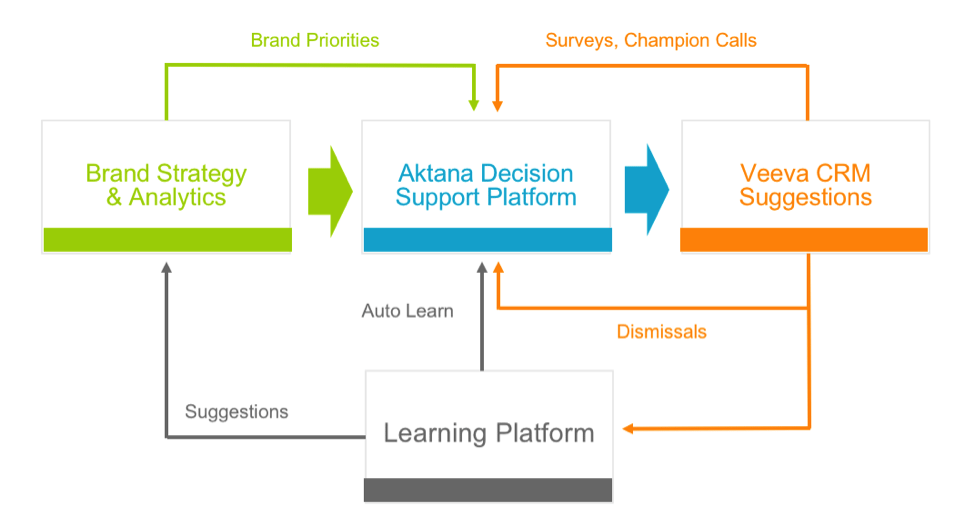Thus far, we’ve discussed best practices for configuring your suggestion platform and the importance of designing suggestions for rep adoption and real-world use. In this concluding part of our series, let’s revisit a recent project with a top-10 pharma to explore how a suggestion platform can (and should) evolve alongside your business to accommodate and reflect the priorities that change over time.
Listening to Field Feedback
Change is inevitable, and as an integral part of how brand priorities are executed in the field, suggestions platforms have to keep up. Listening to feedback from the field, and then adapting suggestions based on that feedback, is one of the key drivers for the continued adoption and impact of suggestions.
In this recent implementation, we continually tweaked the rules and tactics configured in the engine based on ongoing feedback from reps. Not only did this show reps we were listening to their opinions, but it also ensured suggestions continued to be relevant for them and their local business.
From the beginning, suggestions were designed to adapt, and any dismissals were automatically considered when making future suggestions. We also developed and learned rules that determine what to do when certain dismissals appear. Based on this collected feedback, we were able to execute strategies adjusted to rep preferences and feedback (e.g., prioritizing development of more content, considering alternative channel integrations with hard-to-see HCPs, or slowing down the pace of interactions with HCPs who don’t need as frequent contact).
As we learned during the early stages of implementation, gathering qualitative feedback from reps on a frequent basis was critical. In addition to periodic surveys, our customer also set up monthly phone meetings to allow a subset of reps to provide direct feedback on what they were finding most valuable and most challenging. Not only was this a great opportunity to keep a pulse on what to tweak to ensure continued adoption, but it also led to great ideas from field reps on how suggestion platforms could be further improved to provide them with more value.
Monitoring Results
While rep feedback was an important driver of ongoing configuration changes, brand and analytic functions proactively monitored suggestion usage, rep actions and response as well—identifying what was (and wasn’t) working through a reporting platform. In addition to proposing strategy tweaks to optimize suggestions, these reports also identified the need for retraining and district manager coaching in certain territories.
The Importance of Configurability
As a rule, brand priorities shift every quarter due to changes in market dynamics (like new competitors, new indications, access changes or new data sources becoming available). In addition, during initial requirements gathering, there is often a long list of use cases identified as important priorities that were roadmapped for future consideration. Brands often look to incrementally roll these out over time, improving suggestions for reps.
Custom-built suggestion platforms lack the agility to handle this level of ongoing change. When a platform isn’t built from the ground up for flexibility and change, it quickly becomes cost- and time-prohibitive to determine how to translate proposed changes into code whenever conditions shift. That’s why it’s so important to leverage a configurable suggestions platform where the rules governing strategy can be easily iterated on and updated. It’s also important to put the right process in place (typically timed with plan-of-action meetings and sales cycles) to continually identify, prioritize and execute changes as they arise. This effort requires support from either the right internal team trained with the right skill set or a trusted partner who can evaluate these changes on an ongoing basis.
Integrated Learning for Immediate Impact
It didn’t take long for our customers to find that a connected learning platform was invaluable for informing how suggestions could get smarter over time, and translating that acquired knowledge into immediate impact.
- Double-duty data: Because the learning platform and decision support engine are directly integrated, all data already being used to generate suggestions can also be used to correlate rep actions with results.
- Immediate impact: This means that the learnings are immediately actionable as iterations in the configuration. We think of these as “suggestions” for those setting up the platform on what to consider changing in the future.
- Transparency: Just like those received by reps, these suggestions must be both actionable and Based on data and individual preference, brands should be able to decide for themselves whether or not to add a business rule or change the threshold on an existing one.
- Automatic vs. manual: As confidence in suggestions and the learning platform increases over time, you can also set certain factors to auto-learn (within constraints or boundaries set by your team).
Continuous Improvement
From requirements gathering to ensuring suggestions are designed for real-world adoption, there’s no question that the front-end decisions made during the initial configuration process play a major role in your decision support program’s overall success. But as any pharma marketer knows, the work doesn’t end there. Your suggestion platform lives and breathes with your business and, like your business, it will continue to change. As we’ve observed in recent HCP engagements with top global pharmas, consistently monitoring rep feedback and behavior, and connecting actions with results are absolutely integral steps to designing a decision support engine that’s relevant today and ready for tomorrow.

